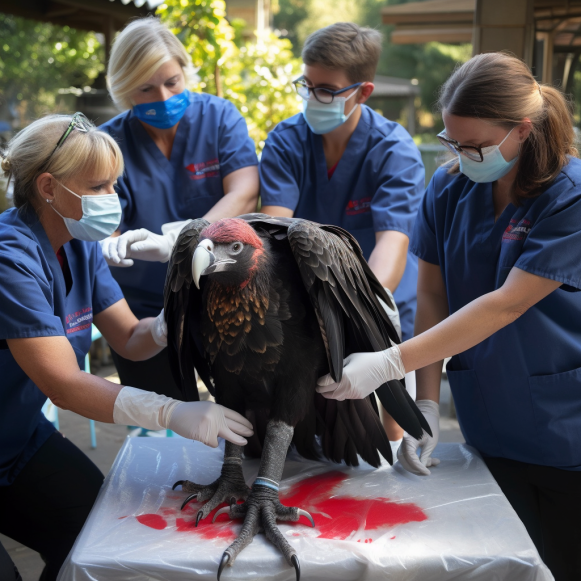New vaccine expected to give endangered California condors protection against deadly bird flu

LOS ANGELES (AP) — Antibodies discovered in early results of a historic new vaccine trial are expected to provide at least partial protection to endangered California condors from the deadliest strain of avian influenza in U.S. history.
The California condor is the only bird species in the United States that has been approved for the new emergency-use vaccine, which was given to condors bred in captivity during a trial this summer at the Los Angeles Zoo, the San Diego Zoo Safari Park, and the Oregon Zoo.
Authorities launched the study following the avian influenza deaths of 21 free-flying condors in Arizona earlier this year, part of a Southwest flock that typically accounts for one-third of the wild population.
Wildlife officials feared that the outbreak’s toll on the California condor population would wipe out any gains made in rebuilding the wild population, prompting efforts to accelerate the vaccine’s development.
After 40 years of recovery efforts to keep the iconic vulture with a 10-foot (3-meter) wingspan from extinction, the wild population now numbers fewer than 350 condors in flocks ranging from the Pacific Northwest to Baja California, Mexico.
“Losing 20 birds effectively means delaying recovery by ten years,” said Dr. Hendrik Nollens, vice president of wildlife health for the San Diego Zoo Wildlife Alliance.
After wreaking havoc across Europe, the so-called bird flu arrived in the United States in February 2022. Agriculture officials in the United States believe this year’s cases are related to last year’s outbreak, which was the country’s deadliest ever.
Authorities confirmed the presence of the flu in commercial poultry flocks in South Dakota and Utah earlier this month, raising concerns ahead of the spring migratory season. The outbreak cost poultry producers nearly 59 million birds in 47 states, including egg-laying chickens, turkeys, and meat chickens. The flu also caused price increases in eggs and turkey for consumers, costing the federal government more than $660 million.
Early results show that when 10 condors were vaccinated with half a milliliter (0.016 fluid ounces) of vaccine on two occasions — an initial injection and a booster administered 21 days later — 60% of the birds developed measurable antibodies that would protect them from avian flu after exposure.
“We’re thankful that we’re getting any immune response,” said Ashleigh Blackford, the US Fish and Wildlife Service’s California condor coordinator.
Hunting during the California Gold Rush in the mid-1800s nearly wiped out the population, as did poisoning from the toxic pesticide DDT and lead ammunition.
Only 22 California condors remained in the wild in the 1980s. To save the species, they were captured and placed in captive breeding programs. Zoo-bred birds were first released into the wild in 1992, and have since been reintroduced into habitats where they had vanished. Conservationists consider the ongoing re-wilding efforts to be a success.
The progress of the bird flu trial will allow wildlife officials to move forward with the release of approximately two dozen vaccinated condors into the wild in California and Arizona by the end of the year. The government is waiting for more information before deciding whether to capture and immunize free-flying condors. Condors in captivity and in the wild are already vaccinated against West Nile virus.
The Oregon Zoo’s director of animal health, Dr. Carlos Sanchez, stated that wildlife officials had concerns about conducting the bird flu vaccine study.
“Human intervention, veterinary intervention, is not something we do all the time or take lightly,” he went on to say. “It wasn’t an easy decision.”
The shots were first tested on black vultures to ensure that they could be safely injected into condors in managed care, which began in July. The post-inoculation monitoring and testing lasted 42 days, and no adverse reactions were reported, according to officials.
Dr. Dominique Keller, chief veterinarian at the Los Angeles Zoo, said taking part in the historic trial was one of the highlights of her career. She hopes that the condor research will lead to the development of bird flu vaccines for other endangered species.
“It was just so incredible to be the first one to hold the vaccine in my hand and actually give it to the first bird,” she went on to say.
The second test group in the trial consists of ten condors who were vaccinated with a single milliliter (0.03 fluid ounces). The results of those birds will determine whether or not wild condors will get the shot.
“We want to look at the data more holistically before we kind of jump ahead to what’s next,” he said.
The condor is inextricably linked to several Native American tribes in the West, and tribal members regard it as equal to, if not superior to, humans. The condor vanished from the Yurok Tribe’s ancestral lands in Northern California in the late 1800s, but it reappeared in 2021 thanks to significant conservation efforts led by Tiana Williams-Claussen, the tribe’s wildlife department director.
Seeing the avian flu wipe out 21 birds in Arizona just a few years later was “deeply impactful” to tribe members, according to Williams-Claussen. The research and vaccine could help to avoid a repeat of the devastation.
“We’re all kind of waiting with bated breath to see what the final results are going to be,” she added.




